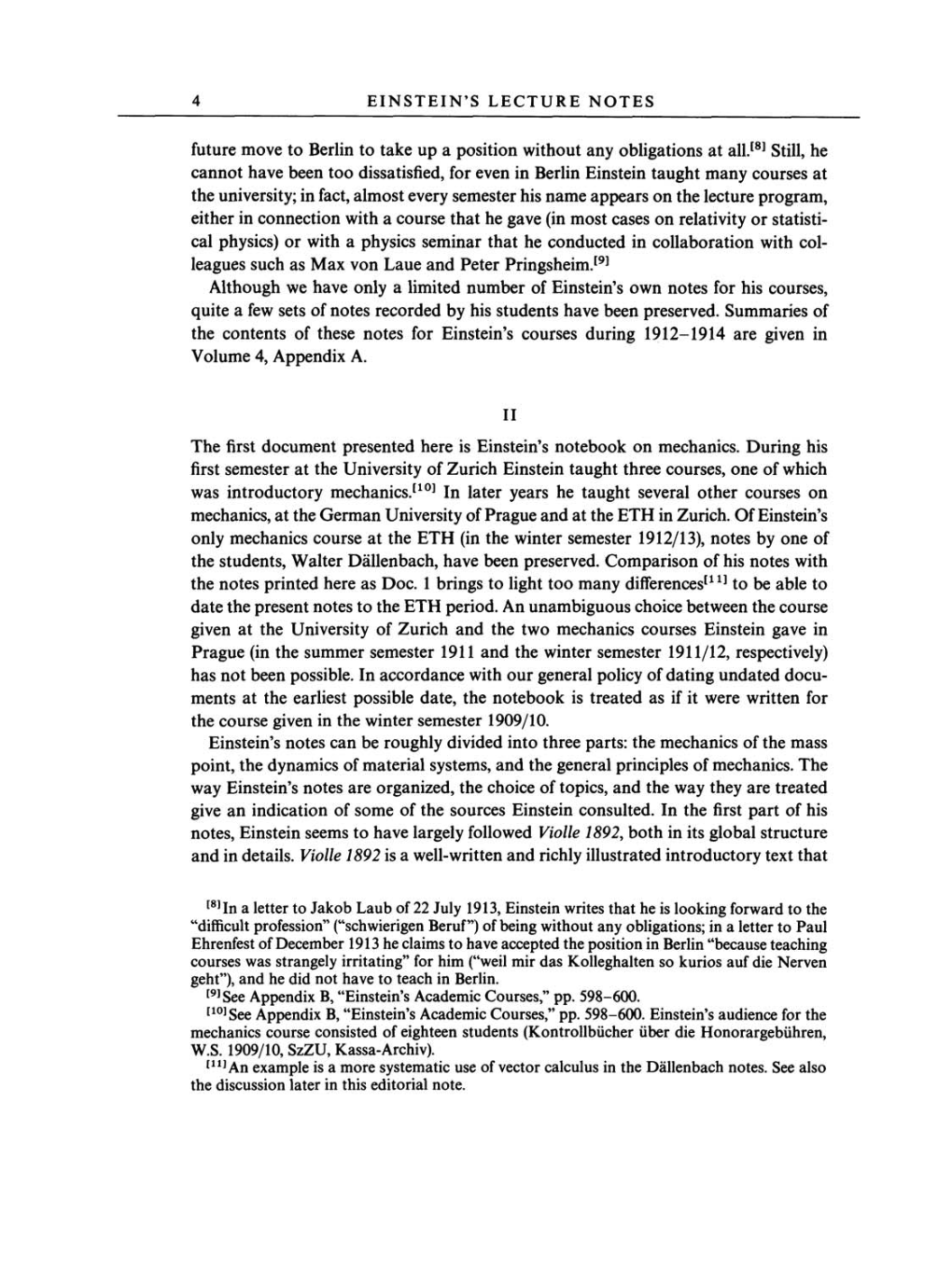4
EINSTEIN'S LECTURE NOTES
future
move
to
Berlin
to
take
up
a
position
without
any obligations
at
all.[8]
Still,
he
cannot
have been
too dissatisfied,
for
even
in
Berlin Einstein
taught many
courses
at
the
university;
in
fact,
almost
every
semester his
name appears
on
the lecture
program,
either in connection with
a
course
that
he
gave
(in
most
cases on
relativity
or
statisti-
cal
physics)
or
with
a
physics
seminar
that
he conducted in collaboration with
col-
leagues
such
as
Max
von
Laue and Peter
Pringsheim.[9]
Although
we
have
only
a
limited number of Einstein's
own
notes
for his
courses,
quite
a
few sets
of
notes
recorded
by
his
students have been
preserved.
Summaries of
the
contents
of these
notes
for Einstein's
courses during
1912-1914
are given
in
Volume
4,
Appendix A.
II
The first document
presented
here
is
Einstein's notebook
on
mechanics.
During
his
first
semester at
the
University
of Zurich Einstein
taught
three
courses,
one
of
which
was
introductory
mechanics.[10]
In later
years
he
taught
several other
courses on
mechanics, at
the German
University
of
Prague
and
at
the ETH
in
Zurich. Of
Einstein's
only
mechanics
course
at
the ETH
(in
the winter
semester
1912/13),
notes
by one
of
the
students,
Walter
Dällenbach,
have been
preserved. Comparison
of
his notes
with
the
notes
printed
here
as
Doc.
1
brings
to
light
too
many
differences[11] to be
able
to
date the
present
notes to
the ETH
period.
An
unambiguous
choice between the
course
given
at
the
University
of Zurich and the
two
mechanics
courses
Einstein
gave
in
Prague (in
the
summer
semester
1911
and the winter
semester
1911/12, respectively)
has
not
been
possible.
In accordance
with
our
general policy
of
dating
undated docu-
ments at
the earliest
possible
date,
the notebook is treated
as
if it
were
written for
the
course
given
in
the winter
semester
1909/10.
Einstein's
notes
can
be
roughly
divided into three
parts:
the mechanics of
the
mass
point,
the
dynamics
of material
systems,
and the
general
principles
of mechanics. The
way
Einstein's
notes
are
organized,
the choice of
topics,
and the
way they
are
treated
give an
indication of
some
of the
sources
Einstein consulted. In the
first part
of his
notes,
Einstein
seems
to
have
largely
followed
Violle
1892,
both
in its
global
structure
and
in
details.
Violle 1892
is a
well-written and
richly
illustrated
introductory
text
that
[8]In
a
letter
to Jakob
Laub of
22
July
1913,
Einstein writes that he
is
looking
forward
to
the
"difficult
profession" ("schwierigen Beruf")
of
being
without
any obligations;
in
a
letter
to
Paul
Ehrenfest of December
1913 he
claims to have
accepted
the
position
in
Berlin "because
teaching
courses
was
strangely irritating"
for him
("weil
mir das
Kolleghalten so
kurios auf
die
Nerven
geht"),
and he did
not
have
to
teach
in Berlin.
[9]See
Appendix B,
"Einstein's Academic
Courses," pp.
598-600.
[10]See Appendix
B,
"Einstein's Academic
Courses," pp.
598-600. Einstein's audience for the
mechanics
course
consisted of
eighteen
students
(Kontrollbücher
über die
Honorargebühren,
W.S.
1909/10,
SzZU, Kassa-Archiv).
[11]An
example
is
a more
systematic
use
of
vector
calculus
in the Dällenbach
notes. See
also
the discussion later
in
this editorial
note.
